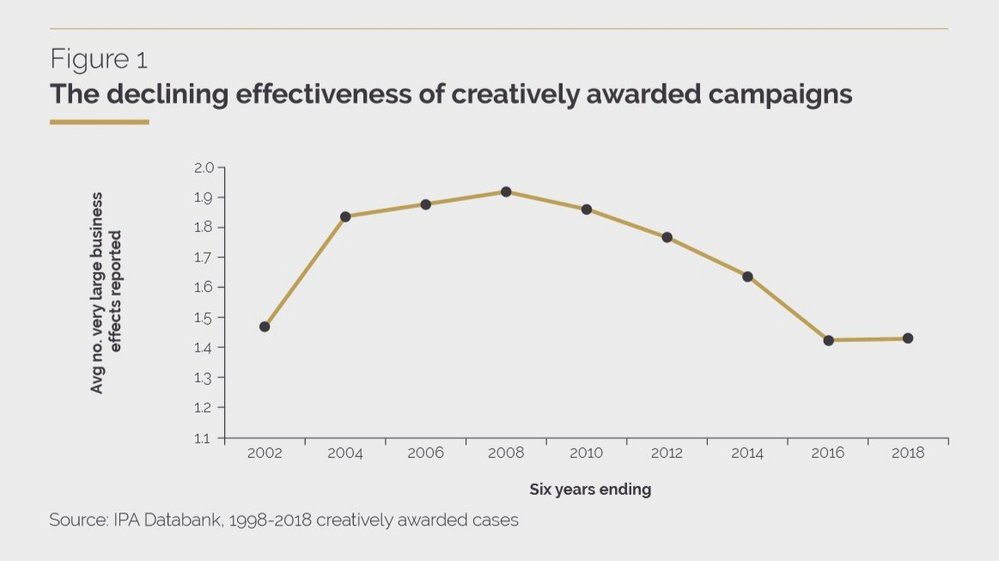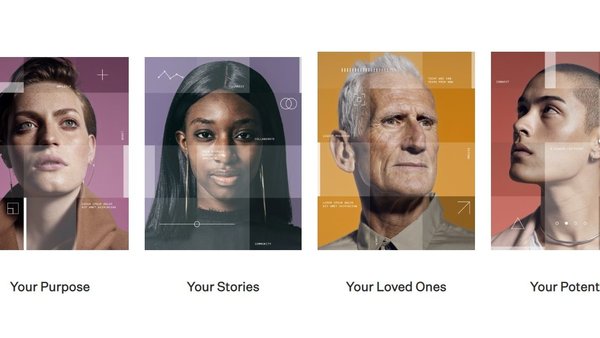Creative effectiveness is collapsing, claims new IPA report /
IPA report shows avalanche of short-term campaigns have rendered creative awards meaningless by destroying effectiveness

A damning new report from consultant Peter Field and the Institute of Practitioners in Advertising (IPA) claims creatively awarded work is now no more effective than non-awarded campaigns, thanks to brands' obsession with short-term sales activations.
Creatively awarded campaigns were around 12 times as efficient* as non-awarded campaigns in the 12-year period ending 2008, but new research shows this multiplier has now dropped to four. And Field believes that if you isolated the past few years of creatively awarded campaigns, they would show efficiencies had been wiped out completely.
‘We have arrived in an era where award-winning creativity typically brings little or no effectiveness advantage,’ stated Field, who calls The Crisis in Creative Effectiveness report ‘a final wake-up call for good sense, before it is too late’.
The report, which is being launched at the Cannes Lions International Festival of Creativity today (19 June), is based on a trove of almost 600 advertising case studies submitted to the IPA (mostly) between 1998 and 2018, cross-referenced with campaigns that won creative awards recognised by the Gunn Report (now part of Warc Rankings).

General Crisis
The slump in the effectiveness of creatively awarded campaigns is part of a ‘bigger and more general crisis in effectiveness’, said Field, who has written extensively on the subject over the years.
Brands have brought this plight on themselves by focusing on short-term sales activations at the expense of long-term brand building, something that Field has warned about in previous reports, written with Adam&eveDDB's head of effectiveness, Les Binet.
Field's research shows that the optimum balance between brand building work and sales activations for campaigns between 2004 and 2016 was 76% and 24%, respectively. But IPA data shows that in the six years ending in 2018, marketers typically under-allocated budget to brand building by at least 14 percentage points.
‘This under allocation is a central reason why effectiveness levels have been falling: we are allowing brands to weaken and, with that, we are losing valuable choice-priming benefits of brand building,’ claimed Field.
Beyond the rise in short-term campaigns, Field warns that long-running campaigns, too, are increasingly eschewing brand building in favour of activation tactics. Not only is this driving down effectiveness, it is ’changing the very nature of the type of advertising we are generally exposed to: instead of emotionally engaging human stories that seek to charm and captivate, we are seeing more didactic, literal presentations that seek to prompt us into action.’

Mis-judged
Meanwhile, the blame for the declining effectiveness of creatively awarded campaigns, said Field, lies with the awards judges.
‘It’s unclear why awards judges increasingly favour short-term campaigns‘, explained Field. ‘It’s a fact that these short-term creatively awarded campaigns on average allocated 2.5 times more of their budget to online media than the long-term creatively awarded campaigns that they are increasingly replacing. Perhaps judges just prefer digitally focused campaigns or data driven creativity?’
More disconcerting, argued Field, is the evidence that creativity is being applied more and more to short-term sales activations, where it will only yield mediocre results. Creativity is best applied to situations when you want to use surprise to catch people’s attention and change their perceptions: brand building, in other words.
‘If you constrain highly creative advertising to work in the short term or simply deliver short-term results, you do even more damage to its effectiveness than you would to less creative campaigns in general,’ said Field, adding: ‘As a result we have witnessed a catastrophic decline in the typical efficiency multiplier achieved by creatively awarded campaigns.’

Performance marketing
But pockets of best practice remain among the evidence of decline and doom. Separating 76 creatively awarded campaigns between 2008-2018 into high performers (those that achieved more than one very large business effect) and low performers (those that did not), Field found high performers were almost half as likely to have short-term goals than low performers. In fact the high-performing campaigns were, on average, tracked over a period that was twice as long.
High-performing campaigns were also more likely to target long-term objectives, like market share growth; favour emotional messaging; achieve fame (although low performers were just as likely to seek it); and target a broader cross-section of society, including people who don’t use the product in question.
According to the report, the IPA also has data that shows high-performing campaigns are more likely to use big data for insight, while low-performing campaigns use it more often for targeting.
To fix the problems outlined in his report, Field suggested two things. First, ‘Those who cherish creativity should stop encouraging the development of disposable creative ideas and [...] stress the importance of how ideas will strengthen the brand over time.’ Second, ‘Creative award shows should have separate classes of awards for short- and long-term creativity.’
* In this report efficiency is measured as percentage points of market share gain p.a. for every 10% points of ESOV invested in the campaign.
Want more of the same? /
We don’t just write about best-in-class campaigns, interviews and trends. Our Members also receive access to briefings, online training, webinars, live events and much more.







